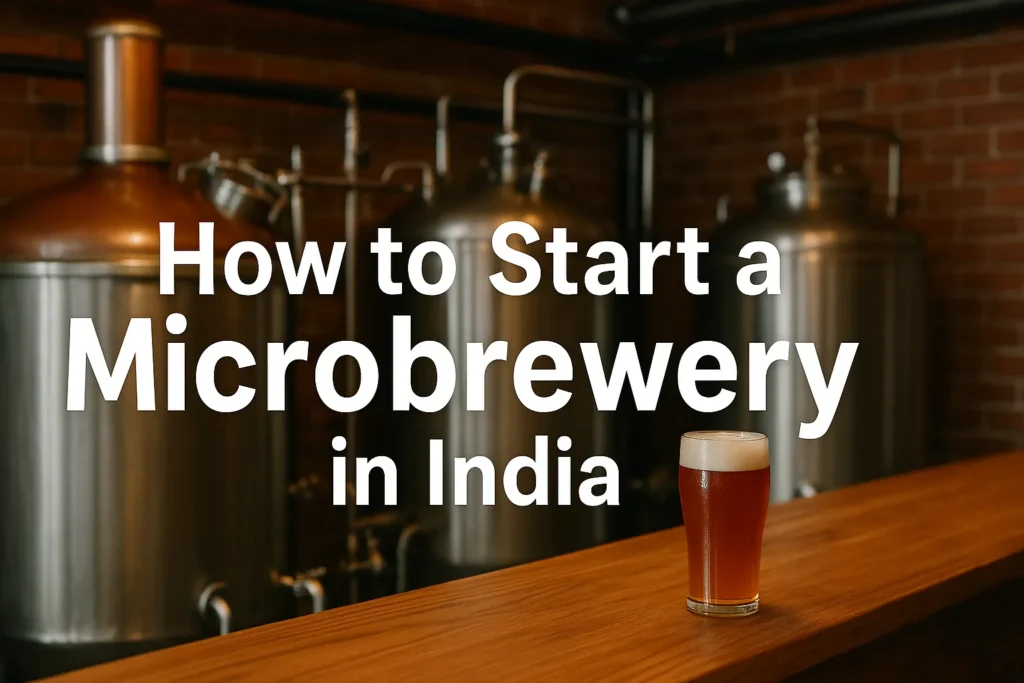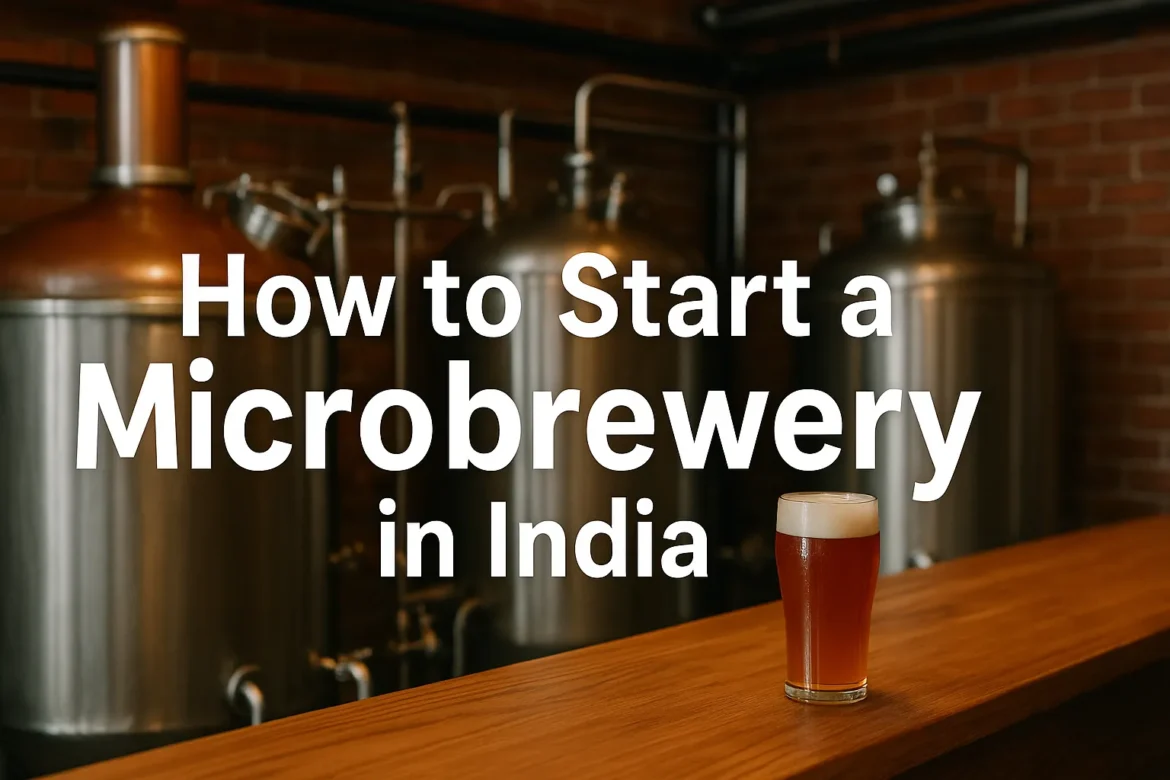Discover how to start a microbrewery in India. Expert insights on ₹1.5 crore minimum investment, state licenses, brewing equipment & 18-24 month break-even.
Picture this: You’re sitting in a bustling Bengaluru brewpub, watching golden liquid cascade from gleaming tanks into frosty mugs, while patrons excitedly discuss the notes of citrus and coriander in their wheat beer. The craft beer revolution has officially taken hold in India, and if you’ve been dreaming about turning your passion for brewing into a thriving business, there’s never been a better time to start a microbrewery in India.
Having spent the last decade documenting brewery cultures across 15 countries and watching India’s craft beer scene explode from just a handful of pioneers to over 300 microbreweries today, I can tell you that the opportunity is real – but so are the challenges. The Indian craft beer market is projected to grow at an impressive CAGR of 24.41% from 2024 to 2032, according to IMARC Group, making it one of the fastest-growing segments in the beverage industry.

But before you start imagining yourself as the next Ankur Jain (founder of the wildly successful Bira 91), let’s dive deep into what it really takes to start a microbrewery in India. Trust me, after interviewing dozens of brewery owners and witnessing both spectacular successes and sobering failures, I’ve learned that knowledge and preparation are your best fermentation agents for success.
The Current State of India’s Microbrewery Market
India’s relationship with beer is evolving faster than a vigorous primary fermentation. While spirits still dominate with about 70% of the alcohol market share, beer consumption is surging, particularly among urban millennials and Gen Z consumers who view craft beer not just as a beverage, but as an experience and lifestyle choice.
When I first started tracking the Indian microbrewery scene in 2015, there were barely 50 operational brewpubs. Today, cities like Bengaluru, Pune, Gurgaon, and Mumbai have become craft beer capitals, with Delhi NCR alone hosting over 40 microbreweries. The market that was worth between ₹75-125 crores just a few years ago has exploded into a multi-thousand crore industry.
What’s driving this growth? Several factors converge perfectly:
- Changing Consumer Preferences: Young Indians are willing to pay premium prices for quality, unique flavors, and authentic experiences
- Rising Disposable Income: The urban middle class has more spending power than ever
- Social Media Culture: Instagram-worthy brewery experiences drive footfall
- Tourism Growth: Both domestic and international tourists seek local craft beer experiences
- Regulatory Relaxation: States are gradually easing restrictions, recognizing the economic benefits
Understanding the Microbrewery Business Model
Before you start a microbrewery in India, it’s crucial to understand that this isn’t just about brewing great beer – it’s about creating a complete experience. A microbrewery typically produces between 5,000 to 50,000 liters daily, focusing on quality over quantity.
Types of Microbrewery Operations
| Business Model | Description | Investment Range | Best For |
|---|---|---|---|
| Brewpub | Restaurant + On-site brewery | ₹1.5-2.5 crores | First-time brewery owners |
| Production Brewery | Focus on kegging/bottling for distribution | ₹2-4 crores | Experienced brewers with distribution network |
| Taproom Brewery | Limited food, focus on beer tasting | ₹1-2 crores | Beer enthusiasts in prime locations |
| Contract Brewing | Use others’ facilities to brew your recipes | ₹50 lakhs-1 crore | Low-capital startups |
The Legal Labyrinth: Navigating Licenses and Regulations
Here’s where things get interesting – and by interesting, I mean complicated. Alcohol in India is a state subject, meaning each state has its own rules, regulations, and fee structures. What works in Karnataka might be completely different in Maharashtra.
Essential Licenses Required
- Brewery License (State Excise Department): This is your golden ticket. Costs vary dramatically – from ₹5 lakhs in Delhi to ₹25 lakhs in Maharashtra. Processing time: 3-12 months.
- FSSAI License: Mandatory for any food business. Since you’re dealing with consumables, you’ll need the State or Central license depending on your turnover projections.
- Environmental Clearance: Required for brewery operations, especially concerning water usage and waste disposal.
- Fire Safety Certificate: Critical for public establishments.
- Trade License: From your local municipal corporation.
- GST Registration: For tax compliance.
- Pollution Control Board NOC: Essential for environmental compliance.
State-Specific Requirements
Currently, only certain states permit microbreweries. Here’s a quick breakdown:
| State | License Fee Range | Special Requirements | Market Maturity |
|---|---|---|---|
| Karnataka | ₹10-15 lakhs | Minimum 3,000 sq ft space | Highly mature |
| Maharashtra | ₹15-25 lakhs | Form BRA submission | Very mature |
| Haryana | ₹8-12 lakhs | Max 8% ABV limit | Growing rapidly |
| Delhi NCR | ₹5-10 lakhs | Only on-site consumption | Saturated |
| Uttar Pradesh | ₹6-10 lakhs | Must be attached to hotel/restaurant | Emerging |
Pro tip from my conversations with successful brewery owners: Budget at least 6-12 months for the licensing process and hire a consultant who specializes in brewery licensing. The ₹1-3 lakhs you’ll spend on consultancy can save you months of bureaucratic nightmares.
Location Strategy: Finding Your Perfect Brewing Spot
Location can make or break your microbrewery dream. When you start a microbrewery in India, you’re not just looking for square footage – you’re seeking the right ecosystem.
Key Location Factors
- Target Demographics: Are there enough craft beer enthusiasts in the area? Corporate hubs and areas with high expat populations typically perform well.
- Competition Analysis: Some competition validates market demand, but oversaturation kills profitability.
- Infrastructure Requirements:
- Minimum 3,000-6,000 sq ft for a brewpub
- Industrial-grade flooring (can handle 500-1000 kg/sq m load)
- 3-phase power connection with backup
- Water supply (you’ll need 5-7 liters of water per liter of beer produced)
- Proper drainage and waste management systems
- Accessibility: Parking availability, public transport connectivity, and visibility from main roads matter immensely.
- Zoning Compliance: Ensure commercial/industrial zoning permits alcohol service.
Based on my research, the sweet spots for new microbreweries in 2025 are emerging Tier-2 cities like Chandigarh, Jaipur, Kochi, and Indore, where competition is lower but demand is rising.
Investment Breakdown: Understanding the Real Costs
Let’s talk money – the topic that separates dreamers from doers. To successfully start a microbrewery in India, you need deep pockets or convincing investors.
Comprehensive Cost Structure
| Category | Cost Range | Details |
|---|---|---|
| Brewing Equipment | ₹50 lakhs – 1 crore | Fermenters, kettles, cooling systems, filtration units |
| Infrastructure Setup | ₹30-50 lakhs | Flooring, plumbing, electrical, HVAC |
| Interiors & Ambiance | ₹20-40 lakhs | Furniture, decor, lighting, sound system |
| Licensing & Permits | ₹10-30 lakhs | Varies significantly by state |
| Raw Materials (Initial) | ₹5-10 lakhs | Malt, hops, yeast, additives |
| Working Capital | ₹15-25 lakhs | 3-6 months operational expenses |
| Marketing & Branding | ₹10-15 lakhs | Logo, website, launch campaigns |
| Contingency | ₹10-20 lakhs | Always budget for surprises |
Total Investment Range: ₹1.5 – 3.5 crores
These aren’t just numbers I’m throwing around – they’re based on actual setups I’ve documented across India. Remember, you can start smaller with a 300-liter capacity system (around ₹50 lakhs total investment) and scale up as demand grows.
Equipment Essentials: Your Brewing Arsenal
The heart of any microbrewery is its equipment. Having toured facilities from Rohit Jafa Brewing Solutions installations to imported German systems, I can tell you that quality equipment is non-negotiable.
Core Brewing Equipment
- Mash Tun: Where grains meet hot water to create wort
- Lauter Tun: Separates liquid wort from grain husks
- Brew Kettle: Where the magic happens – boiling and hop additions
- Fermentation Tanks: Stainless steel vessels where yeast converts sugars to alcohol
- Bright Beer Tanks: For maturation and carbonation
- Cooling System: Glycol chillers for temperature control
- CIP System: Clean-in-place for sanitization
- Control Panel: Automation for consistency
Indian suppliers like Falcon (formerly IG Brewtech) and international players offer various options. Many successful breweries start with partially automated systems to balance cost and efficiency.
Crafting Your Beer Portfolio
Now for the fun part – the beer itself! When you start a microbrewery in India, your beer portfolio becomes your signature. Based on market trends and consumer preferences I’ve tracked, here’s what works:
Recommended Initial Portfolio
- Wheat Beer (Must Have): Light, approachable, perfect for Indian climate
- Lager/Pilsner: Familiar territory for traditional beer drinkers
- IPA: For the craft beer enthusiasts
- Seasonal Special: Mango wheat in summer, spiced ale in winter
- Low-ABV Option: Growing health consciousness demands lighter options
The key is balancing familiarity with innovation. I’ve seen breweries fail by being too experimental too soon. Start with crowd-pleasers, establish your reputation, then introduce adventurous brews.
Want to learn more about crafting the perfect recipes? Check out this comprehensive guide on brewing techniques and recipe development for detailed insights into creating signature beers that’ll keep customers coming back.
Marketing and Branding: Building Your Beer Empire
In today’s social media-driven world, how you present your brewery matters as much as what you brew. The success story of Bira 91, which went from zero to ₹5,000 crore valuation without traditional advertising initially, proves the power of smart branding.
Digital Marketing Essentials
- Instagram-Worthy Aesthetics: Your brewery should be designed for social sharing
- Brewery Tours: Educate and engage customers
- Tasting Events: Build a community of beer enthusiasts
- Collaborations: Partner with food festivals, music events
- Loyalty Programs: Keep customers coming back
The Power of Storytelling
Every successful microbrewery has a story. Whether it’s your journey from corporate life to brewing, your grandmother’s secret ingredient, or your mission to revive ancient Indian brewing traditions – find your narrative and own it.
Operational Excellence: Running Your Microbrewery
Once you start a microbrewery in India, the real work begins. Daily operations require meticulous attention to detail.
Key Operational Areas
Quality Control: Consistency is king. Implement strict QC protocols:
- Regular taste testing panels
- Laboratory analysis for ABV, IBU, and contamination
- Temperature monitoring throughout brewing and storage
- Detailed batch records for traceability
Inventory Management: With ingredients like imported hops costing upwards of ₹2,000/kg, efficient inventory management directly impacts profitability.
Staff Management: You’ll need:
- Head Brewer (₹50,000-1,50,000/month)
- Assistant Brewers (₹25,000-40,000/month)
- Service Staff (₹15,000-25,000/month)
- Marketing Manager (₹40,000-60,000/month)
Regulatory Compliance: Monthly excise returns, quality certificates, and renewal applications – staying compliant is a full-time job.
Financial Projections and ROI
Let’s get realistic about returns. Based on my analysis of operational microbreweries:
Revenue Projections (Year 1-3)
| Year | Monthly Revenue | Annual Revenue | Operating Margin |
|---|---|---|---|
| Year 1 | ₹25-40 lakhs | ₹3-5 crores | 15-20% |
| Year 2 | ₹40-60 lakhs | ₹5-7 crores | 25-30% |
| Year 3 | ₹60-80 lakhs | ₹7-10 crores | 30-35% |
Break-even Point: Typically 18-24 months ROI: 25-35% annually after break-even Payback Period: 3-4 years
These projections assume 60-70% capacity utilization and average pricing of ₹250-350 per pint.
Common Challenges and Solutions
Having witnessed numerous brewery launches, I’ve compiled the most common pitfalls:
Challenge 1: Supply Chain Issues
Problem: Inconsistent availability of quality ingredients Solution: Build relationships with multiple suppliers; maintain buffer stock
Challenge 2: Seasonal Demand Fluctuations
Problem: 40-50% drop in sales during monsoons Solution: Diversify with food offerings, host events, introduce monsoon specials
Challenge 3: Talent Retention
Problem: Skilled brewers getting poached by competitors Solution: Equity participation, performance bonuses, continuous training
Challenge 4: Regulatory Changes
Problem: Sudden policy shifts affecting operations Solution: Join brewery associations, maintain good government relations
Success Stories: Learning from the Best
The journey of Bira 91 from a ₹12 crore seed investment to becoming India’s fourth-largest beer company offers valuable lessons. Despite recent challenges with supply chain and financial stress, Bira’s success in creating a ₹5,000 crore brand in less than a decade proves the potential when you start a microbrewery in India with the right approach.
Similarly, Doolally, which started in 2009 as India’s microbrewery pioneer, has shown that consistency and community building create lasting success. Their taprooms in Mumbai and Pune have become institutions, proving that microbreweries can build loyal followings that transcend trends.
The Road Ahead: Future Trends
As someone who’s been tracking this industry closely, here are trends that will shape India’s microbrewery landscape:
- Sustainability Focus: Zero-waste brewing, local ingredient sourcing
- Non-Alcoholic Craft Options: Health-conscious alternatives
- Hyperlocal Flavors: Incorporating Indian ingredients like kokum, gondhoraj lemon
- Technology Integration: IoT-enabled brewing systems, app-based ordering
- Experience Enhancement: Brewery stays, brewing workshops, beer spas
Your Brewing Journey Starts Now
To successfully start a microbrewery in India requires more than just passion for beer – it demands business acumen, regulatory navigation skills, substantial capital, and endless patience. But for those willing to put in the work, the rewards extend beyond financial returns. You’re not just serving beer; you’re creating gathering spaces, building communities, and contributing to India’s evolving beverage culture.
The craft beer revolution in India is still in its early stages. While challenges exist – from complex regulations to high initial investments – the growing market, changing consumer preferences, and success stories of existing players prove that opportunity abounds.
My advice? Start with thorough research, build a strong team, focus on quality over quantity, and never compromise on the experience you deliver. The Indian craft beer enthusiast is sophisticated, well-traveled, and willing to pay for excellence.
Remember, every great brewery started with someone brave enough to take that first step. Whether you’re a homebrewer ready to go commercial, an entrepreneur seeking the next big opportunity, or a beer lover wanting to turn passion into profession – the time to start a microbrewery in India is now.
As we say in the brewing world, “In beer there is freedom, in wine there is wisdom, in water there is bacteria.” Choose freedom, choose craft, choose to build something extraordinary.
Frequently Asked Questions
1. What is the minimum investment required to start a microbrewery in India?
The minimum investment typically ranges from ₹1.5 to 2.5 crores for a small microbrewery setup, including equipment, licensing, and initial operational costs. However, you can start with contract brewing for around ₹50 lakhs if you’re testing the market.
2. Which states in India allow microbreweries?
Currently, states like Karnataka, Maharashtra, Haryana, Delhi, Uttar Pradesh, West Bengal, Rajasthan, and Assam permit microbreweries. Each state has different regulations and fee structures, so research your specific location thoroughly.
3. How long does it take to get all licenses for a microbrewery?
The licensing process typically takes 6-12 months, depending on the state and completeness of your documentation. Working with experienced consultants can expedite this process significantly.
4. Can I bottle and sell my craft beer outside my microbrewery?
This depends on state regulations. Some states allow kegging for sale to other establishments, while others restrict sales to on-premise consumption only. States like Karnataka and Maharashtra are more liberal with distribution rights.
5. What’s the typical break-even period for a microbrewery in India?
Most microbreweries achieve break-even within 18-24 months of operation, assuming 60-70% capacity utilization and effective marketing. However, this can vary based on location, investment size, and operational efficiency.
About the Author
Dave Hopson is a certified Cicerone® and beer historian who has visited over 200 breweries across 15 countries. With a background in anthropology and culinary arts, Dave brings a unique perspective to understanding beer’s cultural significance. He specializes in documenting regional brewing traditions and hosts the popular podcast “Hop Tales,” where he interviews brewers about their cultural inspirations and brewing philosophies. For more insights on beer culture and brewing trends, reach out at dave.hopson@brewmybeer.online

